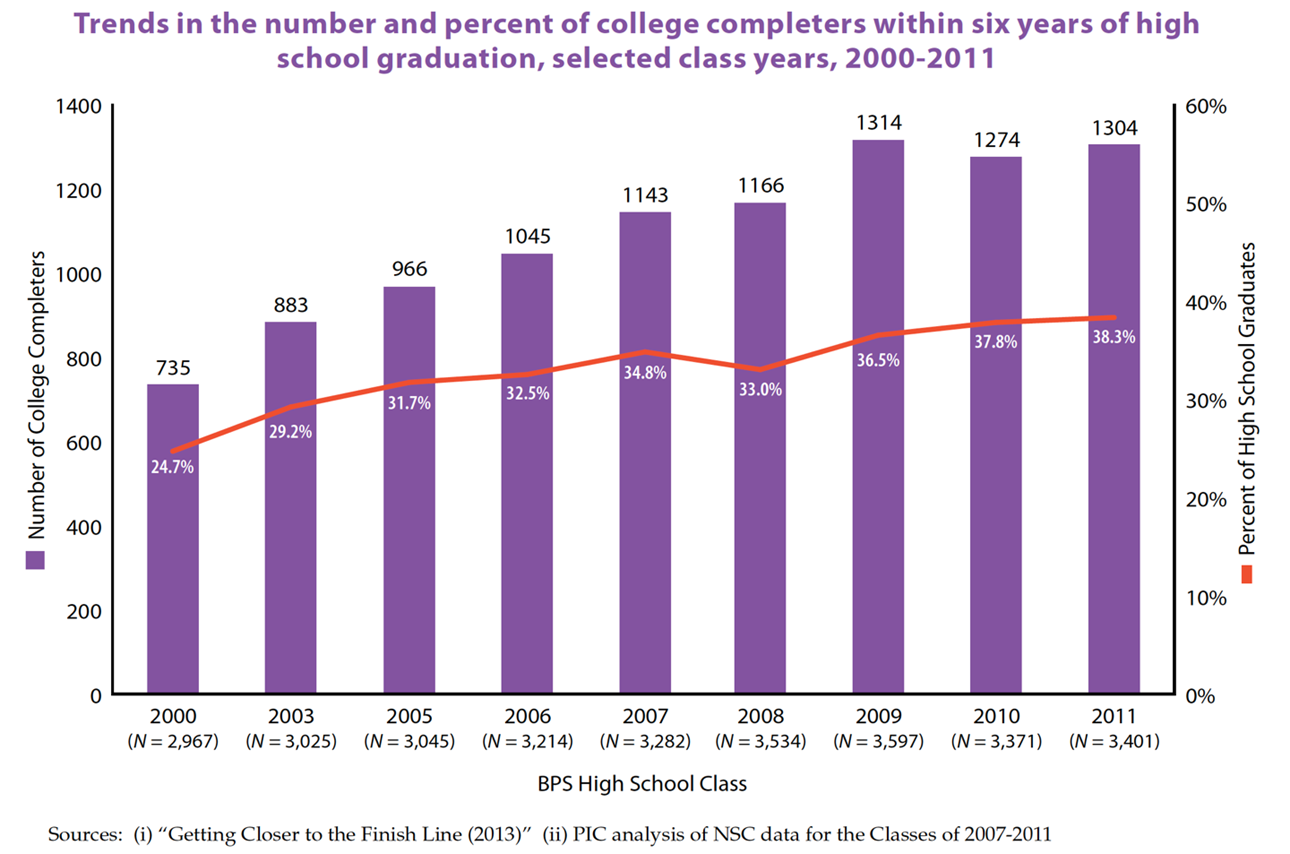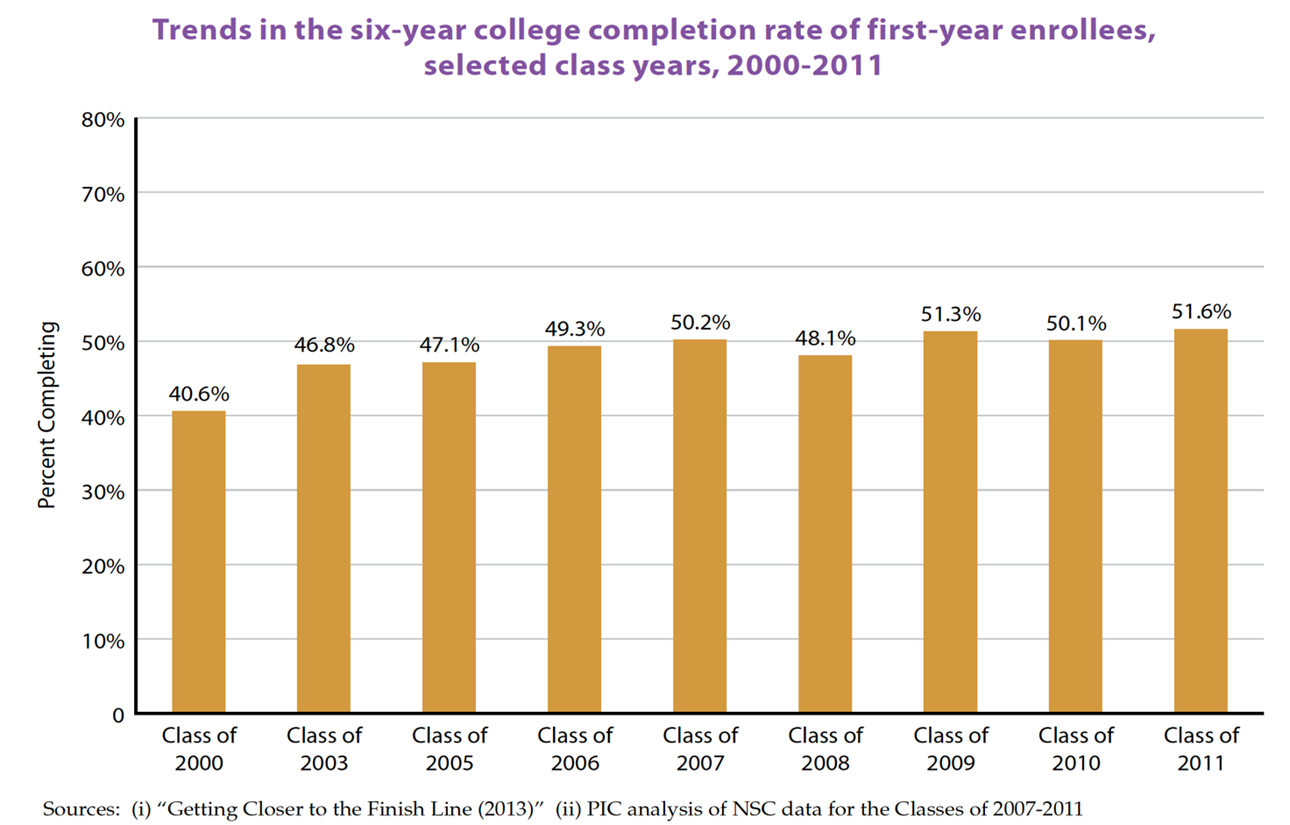Number of BPS graduates completing college rises to record high for Class of 2011, but challenges remain
52 percent of Boston Public Schools graduates who attend higher education programs complete degrees within 6 years
April 11, 2018
Boston – A report from the Boston Private Industry Council and the Success Boston college completion initiative finds the number of Boston Public Schools graduates attending and completing college within six years has nearly doubled in the past decade – but challenges remain to continue the city’s upward trajectory in higher education success rates.
The report, Staying the Course: Six-Year College Enrollment and Completion Experiences of BPS Class of 2011 Graduates, was released this morning at the Boston Foundation. The report looks at the changes in college completion rate for Boston Public Schools graduates in the decade since a 2008 report found less than a quarter of BPS Class of 2000 graduates (and only 39% of BPS college enrollees) completed a program within six years. The finding led to the launch of the Success Boston college completion initiative and a city-wide cooperative effort to get students ready, into and through college.
Since the release of the 2008 report, the Boston Public Schools has not only increased the percentage of graduates who go to college, but the number of BPS grads who complete it. For the Class of 2011, more than 38% of the graduating class had received a degree within 6 years of high school graduation, up 14 percentage points from the Class of 2000. In raw numbers, the number of BPS graduates completing college rose from 735 for the Class of 2000 to 1,304 for the Class of 2011 – an increase of 77%.
The six-year college completion rate of graduates who enroll in college during the first year after high school has reached 52%, the highest recorded to date. For students entering the fall immediately after graduation, it’s 55.2% - closing in on a national average of 61.7%, and noteworthy when one factors in that more than 80 percent of Boston high school students are low income.
"This report demonstrates the importance of increasing access to higher education and providing more pathways for upward mobility for our students," said Mayor Martin J. Walsh. "Education is the most effective tool we have for moving people upwards in our economy. We will continue our work in opening more doors of opportunity for young people to learn and develop the skills necessary to become part of Boston's talented workforce."
“There is a great story to tell here,” said Paul S. Grogan, President and CEO of the Boston Foundation. “This report demonstrates that cooperative efforts to support student success have created hundreds of new college graduates each year, whose lifetime earnings will be hundreds of thousands of dollars higher than they would be without a degree. By getting students ready, in and through to college completion, we are changing the trajectory of entire families moving forward.”
The partners acknowledge that the effort has fallen short of the aspirational goal of doubling the city’s college completion rate in just ten years, yet there is much to celebrate in the 52% completion rate coupled with the 80.5% college attendance rate for Boston Public Schools graduates – both of which are the highest percentages on record.
“This report captures what has been a decade of steady progress for the Boston Public Schools and its graduates,” said Boston Schools Superintendent Tommy Chang. “It is the result of an effort that begins long before high school graduation day in the halls of dozens of schools, where dedicated teachers, administrators and staff work tirelessly with students to build a culture of success – in high school and beyond – for every student.”
“These results are the demonstrated payoff of years of hard work to help hundreds of young people, many of whom are the first in their families to go to college, navigate what can be a challenging system,” said Kenneth C. Montgomery, First Vice President and COO of the Federal Reserve Bank of Boston. “Success Boston and our focus on college attendance and completion in general are not only helping students succeed today, they are giving us insights into how we can better create structures that keep them on-track.” Montgomery is Chair of the Boston Private Industry Council, a Success Boston partner and producer of the report.
Completion gaps remain by race, gender – but some positive signs emerge
Despite the demonstrable improvements in completion, the partners continue to work to eliminate measurable gaps in performance by race and gender. Female BPS graduates are about 11% more likely to go to college than male graduates, and the research continues to show a gap in college attendance and completion rates for White and Asian students and their Black and Latino peers.
But the report does capture some significant shifts over the decade, most notably among Latinos. Changing demographics and increases in college enrollment and completion have led to sharp growth in the number of Latino BPS graduates earning degrees. The number of Latino BPS graduates earning postsecondary credentials has risen to more than 300 for the Class from 2011, more than twice as many as were identified in the Class of 2005 by the 2013 Success Boston report Getting Closer to the Finish Line.
“As higher education institutions, we must continue to strive to meet both the academic and non-academic needs of our Black and Latino students, through coaching, support systems and by removing obstacles to student success,” said Pam Eddinger, President of Bunker Hill Community College. “But even as we strive to do better, we should recognize the important shift happening – students of color are earning certificates and degrees at levels we have never before seen.”
The data also show that Boston’s exam school graduates were twice as likely as their traditional school peers to complete college in 6 years, 77% to 38%. BPS pilot school graduates completed at a 47% rate.
Postsecondary school type also played a role - Six-year college completion rates of BPS Class of 2011 first-year enrollees ranged from 24.0% at two-year public institutions to 63.8% at four-year public and 67.3% at four-year private institutions.
The power of uninterrupted attendance
The research also demonstrated another perceived truth about postsecondary education – that gaps in attendance can become permanent. The college completion rate for students who started at a two-year school and took full-time coursework for their first 4 semesters was nearly 70 percent. That fell by nearly half for students who mixed full-time and part-time courseloads (39%) and by well over two-thirds for part-time two-year college students (19%).
Taking a break from courses entirely for one or more semesters was almost a certain path to failing to complete. Just 8 percent of BPS students who took time off completed any postsecondary credential within six years.
****
The Boston Foundation, Greater Boston’s community foundation, is one of the largest community foundations in the nation, with net assets of more than $1 billion. In 2017, the Foundation and its donors paid $130 million in grants to nonprofit organizations and received gifts of more than $194 million. The Foundation is a close partner in philanthropy with its donors, with more than 1,000 separate charitable funds established either for the general benefit of the community or for special purposes. It also serves as a major civic leader, think tank and advocacy organization, commissioning research into the most critical issues of our time and helping to shape public policy designed to advance opportunity for everyone in Greater Boston. The Philanthropic Initiative (TPI), a distinct operating unit of the Foundation, designs and implements customized philanthropic strategies for families, foundations and corporations around the globe. For more information about the Boston Foundation and TPI, visit tbf.org or call 617-338-1700.


